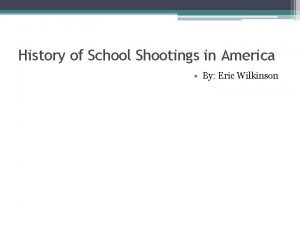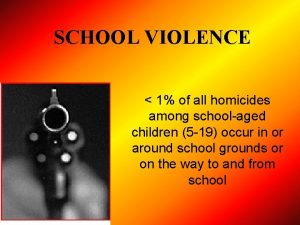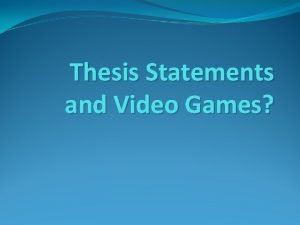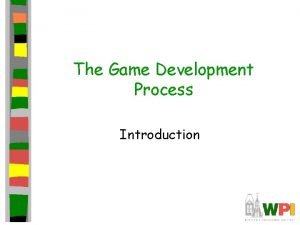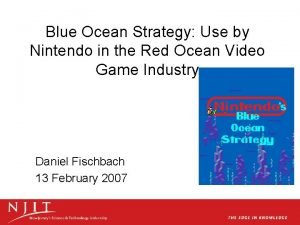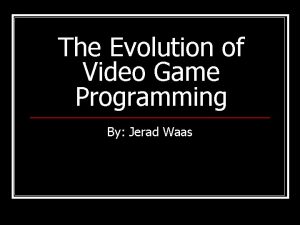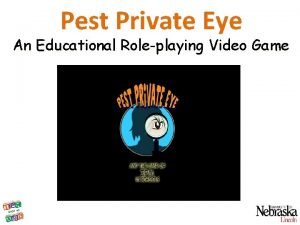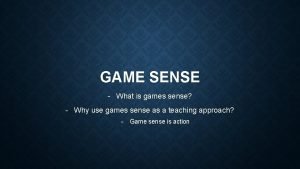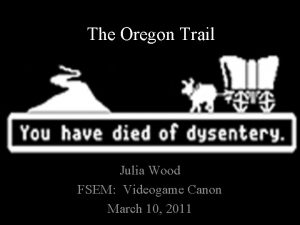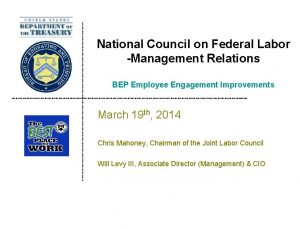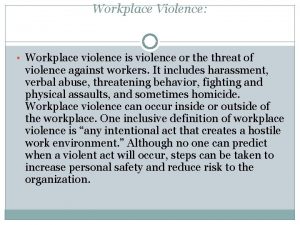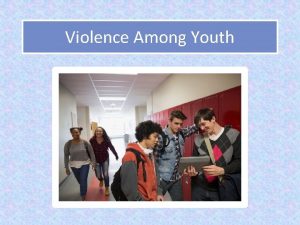Video Game Violence J Parker USA School Shootings




































- Slides: 36

Video Game Violence J Parker

USA School Shootings - Motive Bath School disaster Bath Township, Michigan May 18 1927 45 School board member Andrew Kehoe, who was upset by a property tax that had been levied to fund the construction of a school building. University of Texas at Austin massacre Austin, Texas August 1 1966 17 dysfunctional family, abuse of amphetamines, brain tumour. Orangeburg massacre Orangeburg, South Carolina February 8 1968 3 Police shooting at protesters.

USA School Shootings - Motive Kent State shootings Kent, Ohio May 4 1970 4 National guard shooting protesters. Jackson State shootings Jackson, Mississippi May 14 -15 1970 2 Police shooting at protesters. Olean High School shooting Olean, New York December 30 1974 3 Shooting from school at passersby. Attempted suicide by cop. Cal State Fullerton library massacre Fullerton, California July 12 1976 7 paranoid schizophrenia

USA School Shootings - Motive Cleveland Elementary School shooting San Diego, California, United States January 29 1979 2 "I don't like Mondays. ” Booze/PCP, sexual abuse. Parkway South Junior High School Saint Louis, Missouri, United States January 20 1983 2 Bullying? Cleveland Elementary School shooting Stockton, California, United States January 17 1989 6 Racial. University of Iowa shooting Iowa City, Iowa, United States November 1 1991 6 Did not win scholarship/prize.

USA School Shootings - Motive Lindhurst High School shooting Marysville, California, United States May 1 1992 4 Loss of job/failure to graduate. Simon's Rock College of Bard shooting Great Barrington, Massachusetts, United States December 14 1992 2 Hate crime/schizophrenia Richland High School shooting Lynnville, Tennessee, United States November 15 1995 2 bullying/drugs/home life. Death metal; /Natural Born Killers. Frontier Junior High shooting Moses Lake, Washington, United States February 2 1996 3 Bullying->? depression. Jeremy by Pearl Jam; Rage; film Natural Born Killers

USA School Shootings - Motive Hetzel Union Building shooting State College, Pennsylvania, United States September 17 1996 1 Bethel Regional High School shooting Bethel, Alaska, United States February 19 1997 2 Bullying Hate crime/schizophrenia Pearl High School shooting Pearl, Mississippi, United States October 1 1997 3 Bullying. “I killed because people like me are mistreated every day. ” Heath High School shooting West Paducah, Kentucky, United States December 1 1997 3 Bullying/Schizophrenia

USA School Shootings - Motive Westside Middle School shooting Jonesboro, Arkansas, United States March 24 1998 5 Family issues, anger, bullying. Parker Middle School shooting Edinboro, Pennsylvania, United States April 24 1998 1 Mental illness/depression Thurston High School shooting Springfield, Oregon, United States May 21 1998 4 mental illness, retardation.

USA School Shootings - Motive Columbine High School massacre Jefferson County, Colorado, United States April 20 1999 15 Bullying, depression. Doom and Wolfenstein 3 D. Some analysts argued that part of the killers' problem may have been desensitization due to their constant exposure to violent imagery in such video games, as well as music and movies, theorizing that their obsession with these forms of media may have led them to depersonalization.

USA School Shootings - Motive Columbine High School massacre American media compared the massacre to a fantasy sequence from the 1995 film The Basketball Diaries in which protagonist Leonardo Di. Caprio wears a black trench coat and shoots six classmates in his school's hallways. Several unsuccessful lawsuits against video game manufacturers were filed as a result by parents of some of the victims. [22][23] Harris and Klebold were fans of the movie Natural Born Killers and used the film's acronym NBK as a code in their home videos and journals

USA School Shootings - Motive Heritage High School shooting Conyers, Georgia, United States May 20 1999 0 Failed romance. Voices. Buell Elementary School shooting Mount Morris Township, Michigan, February 29 2000 1 Shooter was 6 years old. Santana High School shooting Santee, California, March 5 2001 2 Peer pressure, bullying. Linkin Park - One Step Closer Granite Hills High School shooting El Cajon, California, United States March 22, 2001 0 Unknown, but "not very popular".

USA School Shootings - Motive Appalachian School of Law shooting Grundy, Virginia, January 16 2002 3 Poor academic performance. Red Lion Junior High School shootings Red Lion, Pennsylvania, April 24 2003 2 Unknown. Case Western Reserve University shooting Cleveland, Ohio, May 9 2003 1 Vendetta (Bullying/anger) Rocori High School shootings Cold Spring, Minnesota, September 24 2003 2 Accidental/bullying

And on it goes … Of the 44 episodes, we find: Bullying xxxxxxx 13 30% Other xxxxxxx 7 16% Insanity xxxxx 5 11% Preexisting conflict xxxxx 5 11% Suicide xxx 3 Family xxxxx 5 Race/Hate xx 2 4. 5% School xx 2 4. 5% Romance x 1 2% Media mentioned 1999+ xxx 7. 5% 11%




D. O. J. report, "Recently, the offending rates for 14 -17 year-olds reached the lowest levels ever recorded. "

• College students at Iowa State University who reported spending greater time with video games (both violent and non-violent) during junior high and high school engaged in more self-reported aggressive behavior as adults. (Anderson & Dill, Journal of the American Psychological Association, 2000) • Second-grade boys displayed more aggressive behavior right after playing a violent video game than boys who played a "nonaggressive" game. (Irwin & Gross, Journal of Family Violence, 1995, Volume 10) • Male college students who played a more violent version of Mortal Kombat scored higher on hostility measures and had higher blood pressure than those who played a less violent version (Ballard & Wiest, Society for Research in Child Development, Spring, 1995)

• Children who played Mortal Kombat responded more negatively to six provocative story questions than those who played a non-violent video game. (Kirsh, ERIC, 1998) • The level of aggression of 153 middle and high school students (as measured by teachers) was positively correlated with the amount of students' self-reported video game play. (Fling, Smith, Rodriguez, Thornton, Atkins & Nixon, Southwest Texas State University, 1992)

Positive • University students show similar performance on hostility and personality measures after playing with games containing different levels of violence (Strathclyde University, 1995) • Recent survey figures (for the Interactive Digital Software Association) suggest that video games encourage socialization with family and friends. More specifically, out of 1500 individuals and families surveyed, 42% reported that they enjoy playing games because they can be shared with friends and family (2002). (Note: this study did not separate out violent from non-violent video games, but looked at gameplay as a whole. )

Positive • A literature review of 59 studies conducted by the Washington State Dept of Health concludes that current research evidence is not supportive of a major concern that violent games lead to real life violence. (Bensley and Van Eenwyk, Journal of Adolescent Health, Vol 29, 2001) • Time spent playing with video games was not correlated with aggression for middle school kids (144 females, 134 males), although boys with a preference for aggressive games were perceived as more aggressive by peers. (Wiegman & van Shie, Social Psychology, 1998)

Positive • No differences in measures of aggressive thought were found for 52 3 rd and 4 th graders who played Mortal Kombat versus a basketball sim. (Kirsh, Childhood- a Global Journal of Child Research, 5, Volume 2, 1998)

Research Inconsistencies 1. Many of the studies examine only short-term consequences in the form of behavior immediately following exposure to video game violence, as opposed to examining any long-term effects. 2. Each study uses different types of video games (e. g. sports, shooters, action/adventure) with different types and "levels" of violence. Some studies don't report the type or names of video games used in the investigation. These factors make comparisons and conclusions difficult to ascertain.

Research Inconsistencies 3. Much of the research is correlational only. Relationships may be shown, but they may be coincidental or caused by other individual, family and social factors. 4. Games have become more realistic in graphics and sounds, in essence a different animal than those used in much of the research. Many studies were conducted using older platforms and games, making them less easily generalized or comparable to more recent games.

In an analysis of the risk factors of youth violence by the Surgeon General of the United States of America, violent media is categorized as 'Small Effect Size. ' In fact, there are 27 risk factors rated higher than exposure to violent media, like socioeconomic status, academic failure, poor parent-child relations, weak social ties, and being male.


H Jenkins – 8 myths 1. The availability of video games has led to an epidemic of youth violence. - rate of juvenile violent crime in the United States is at a 30 -year low. - people serving time for violent crimes typically consume less media before committing their crimes than the average person in the general population. - young people in general are more likely to be gamers — 90 percent of boys and 40 percent of girls play. - -The overwhelming majority of kids who play do NOT commit antisocial acts. - - strongest risk factors for school shootings centered on mental stability and the quality of home life

H Jenkins – 8 myths 2. Scientific evidence links violent game play with youth aggression. . " This research includes some 300 studies of media violence. - most of those studies are inconclusive and many have been criticized on methodological grounds. In these studies, media images are removed from any narrative context. Subjects are asked to engage with content that they would not normally consume and may not understand. Finally, the laboratory context is radically different from the environments where games would normally be played. - Most studies found a correlation, not a causal relationship, - no research has found that video games are a primary factor or that violent video game play could turn an otherwise normal person into a killer.

H Jenkins – 8 myths 3. Children are the primary market for video games. While most American kids do play video games, the center of the video game market has shifted older as the first generation of gamers continues to play into adulthood. - 62 percent of the console market and 66 percent of the PC market is age 18 or older. - One quarter of children ages 11 to 16 identify an M-Rated (Mature Content) game as among their favorites. - The Federal Trade Commission has found that 83 percent of game purchases for underage consumers are made by parents or by parents and children together.

H Jenkins – 8 myths 4. Almost no girls play computer games. Historically, the video game market has been predominantly male. - the percentage of women playing games has steadily increased over the past decade. Women now slightly outnumber men playing Web-based games. - Spurred by the belief that games were an important gateway into other kinds of digital literacy, efforts were made in the mid-90 s to build games that appealed to girls. More recent games such as The Sims were huge crossover successes that attracted many women. - Yet it's also important to note that female game characters are often portrayed as powerful and independent. In his book Killing Monsters, Gerard Jones argues that young girls often build upon these representations of strong women warriors as a means of building up their self confidence in confronting challenges in their everyday lives.

H Jenkins – 8 myths 5. Because games are used to train soldiers to kill, they have the same impact on the kids who play them. Former military psychologist and moral reformer David Grossman argues that because the military uses games in training (including, he claims, training soldiers to shoot and kill), the generation of young people who play such games are similarly being brutalized and conditioned to be aggressive in their everyday social interactions. Grossman's model only works if: we remove training and education from a meaningful cultural context. we assume learners have no conscious goals and that they show no resistance to what they are being taught. we assume that they unwittingly apply what they learn in a fantasy environment to real world spaces.

The military uses games as part of a specific curriculum, with clearly defined goals, in a context where students actively want to learn and have a need for the information being transmitted. There are consequences for not mastering those skills. That being said, a growing body of research does suggest that games can enhance learning. In his recent book, What Video Games Have to Teach Us About Learning and Literacy, James Gee describes game players as active problem solvers who do not see mistakes as errors, but as opportunities for improvement.

H Jenkins – 8 myths 6. Video games are not a meaningful form of expression. On April 19, 2002, U. S. District Judge Stephen N. Limbaugh Sr. ruled that video games do not convey ideas and thus enjoy no constitutional protection. As evidence, Saint Louis County presented the judge with videotaped excerpts from four games, all within a narrow range of genres, and all the subject of previous controversy. Overturning a similar decision in Indianapolis, Federal Court of Appeals Judge Richard Posner noted: "Violence has always been and remains a central interest of humankind a recurrent, even obsessive theme of culture both high and low. It engages the interest of children from an early age, as anyone familiar with the classic fairy tales collected by Grimm, Andersen, and Perrault are aware. "

Posner adds, "To shield children right up to the age of 18 from exposure to violent descriptions and images would not only be quixotic, but deforming; it would leave them unequipped to cope with the world as we know it. " Many early games were little more than shooting galleries where players were encouraged to blast everything that moved. Many current games are designed to be ethical testing grounds. They allow players to navigate an expansive and open-ended world, make their own choices and witness their consequences. The Sims designer Will Wright argues that games are perhaps the only medium that allows us to experience guilt over the actions of fictional characters. In a movie, one can always pull back and condemn the character or the artist when they cross certain social boundaries. But in playing a game, we choose what happens to the characters. In the right circumstances, we can be encouraged to examine our own values by seeing how we behave within virtual space.

H Jenkins – 8 myths 7. Video game play is socially isolating. - Almost 60 percent of frequent gamers play with friends. - Thirty-three percent play with siblings and 25 percent play with spouses or parents. - Even games designed for single players are often played socially, with one person giving advice to another holding a joystick. - A growing number of games are designed for multiple players — for either cooperative play in the same space or online play with distributed players. - Sociologist Talmadge Wright has logged many hours observing online communities interact with and react to violent video games, concluding that meta-gaming (conversation about game content) provides a context for thinking about rules and rule-breaking. Two players may be fighting to death on screen and growing closer as friends off screen. Social expectations are reaffirmed through the social contract governing play, even as they are symbolically cast aside within the transgressive fantasies represented onscreen.

H Jenkins – 8 myths 8. Video game play is desensitizing. Classic studies of play behavior among primates suggest that apes make basic distinctions between play fighting and actual combat. In some circumstances, they seem to take pleasure wrestling and tousling with each other. In others, they might rip each other apart in mortal combat. Game designer and play theorist Eric Zimmerman describes the ways we understand play as distinctive from reality as entering the "magic circle. " The same action — say, sweeping a floor — may take on different meanings in play (as in playing house) than in reality (housework). Play allows kids to express feelings and impulses that have to be carefully held in check in their real-world interactions. Media reformers argue that playing violent video games can cause a lack of empathy for real-world victims. Yet, a child who responds to a video game the same way he or she responds to a real-world tragedy could be showing symptoms of being severely emotionally disturbed.

Here's where the media effects research, which often uses punching rubber dolls as a marker of real-world aggression, becomes problematic. The kid who is punching a toy designed for this purpose is still within the "magic circle" of play and understands her actions on those terms. Such research shows us only that violent play leads to more violent play.
 History of school shootings
History of school shootings Parker middle school shooting
Parker middle school shooting School violence facts
School violence facts Videoyandex
Videoyandex Video.search.yahoo.com search video
Video.search.yahoo.com search video Video.search.yahoo.com
Video.search.yahoo.com Digital media primer
Digital media primer Thesis statement about gaming
Thesis statement about gaming Video game development timeline
Video game development timeline Video game transformations
Video game transformations Nintendo wii blue ocean strategy
Nintendo wii blue ocean strategy Video game
Video game Video game
Video game Video game 1998
Video game 1998 In a video game you earn 5 points for each jewel
In a video game you earn 5 points for each jewel Eric thinks doing schoolwork is one big video game
Eric thinks doing schoolwork is one big video game Nnn video game
Nnn video game Complete as interrogações abaixo usando o past continuous
Complete as interrogações abaixo usando o past continuous Linha do tempo dos videogames
Linha do tempo dos videogames Brian perry lawyer
Brian perry lawyer First generation of video game consoles
First generation of video game consoles Private eye video game
Private eye video game Video game
Video game Video game protection
Video game protection Video game
Video game Story video game
Story video game What is game sense in video games
What is game sense in video games Xiao video game
Xiao video game Heather titus
Heather titus Oregon trail 2001
Oregon trail 2001 Baki video game
Baki video game Todd parker byu devotional
Todd parker byu devotional Fleuty classification of fold
Fleuty classification of fold Parker solar probe timeline
Parker solar probe timeline Parker metamora ohio
Parker metamora ohio Jet pipe servo valve
Jet pipe servo valve Mary golda ross
Mary golda ross
